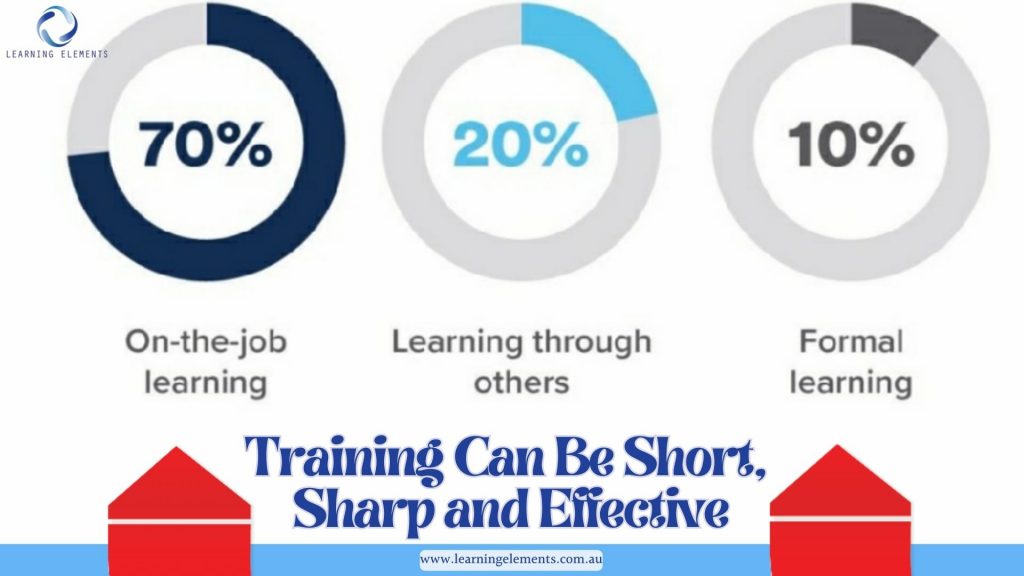Instructor Led or Self Paced Online Training, When and How
Online training is an effective way to develop skills and transfer information for new starters and existing staff. In current times, with isolation and social distancing, there may be more of a need to conduct/facilitate training in the online space.
The Power of Online Training: Enhancing Skills and Knowledge Development
Online instructor-led training is like training that occurs in a classroom where a trainer uses presentations, facilitates discussion and activities, and uses props. The program duration may be a short 30-minute workshop, a full day, or training that runs for days/week. Each program has its own unique objective, content, and session plan.
Effective self-paced training is short. Think micro modules that are 5 mins in duration or 30-minute modules. Anything longer can lead to a lack of concentration and low retention of information for learners. Videos, knowledge checks and activities can be easily incorporated into self-paced online modules to engage learners and must be used with a specific objective in mind.
Have you ever been at a party where someone has talked to you non-stop for what feels like an eternity?
Training where a facilitator talks non-stop and modules that are dry and text-heavy can have the same effect on a learner as being talked at by a person. It can induce heavy sleep, distraction and be ineffective.
Blending instructor-led and self-paced training is a highly effective way to develop skills and increase knowledge. To ensure effective online training, trainers should keep topics concise. The trainer should also encourage discussion, adhere to timelines, and provide clear instructions for self-paced modules.
Providing learners with clear guidelines and completion dates for self-paced online training for compliance-type training is trackable with the use of an LMS. Microlearning can also be used in an online format to share information in small chunks.
As with any training, purpose shapes format, content, and learner expectations, ensuring alignment with objectives. Online training is a very effective way to create and deliver learning paths for individuals and teams. Using a combination of methods and resources can engage learners to meet training objectives.
Harnessing Interactive Learning Technologies for Engaging Online Training
Harnessing interactive learning technologies revolutionises online training effectiveness. By leveraging tools such as virtual reality, augmented reality, gamification, and simulations, organisations create immersive experiences that captivate learners’ attention. Virtual reality transports learners to realistic settings, providing hands-on experiences for skill development. Augmented reality overlays digital content onto the real world, enabling interaction with virtual elements. Gamification techniques, like leaderboards and rewards, transform online training into a playful and engaging experience. Simulations replicate real-life scenarios, allowing learners to practise decision-making and critical thinking in a risk-free environment. Embracing these technologies enhances learning outcomes and creates impactful training experiences.
These innovative approaches foster deeper learning, retention, and application of knowledge. Learners are actively engaged, making the training journey enjoyable and memorable. By embracing interactive learning technologies, organisations can elevate their online training programs to new heights and have a significant impact on the effectiveness of their training initiatives.
Enhancing Learning Design with Storyboards: Maximising the Effectiveness of Interactive Training
Storyboards are powerful tools in the design and development of interactive learning experiences, complementing the use of interactive learning technologies. Storyboards visually represent training flow, structure, and content for a cohesive and engaging learner journey.
When creating online training with interactive elements, storyboards help instructional designers and developers plan the sequence of activities, interactions, and assessments. They provide a blueprint for the overall design, allowing stakeholders to visualise the learner’s experience and make informed decisions about the content and functionality.
By using storyboards, instructional designers and developers can iterate and refine the design before investing significant resources in development. They allow for early feedback and collaboration with stakeholders, resulting in a more polished and effective end product.
Additionally, storyboards facilitate communication between team members involved in the training development process. They serve as a common reference point, ensuring a shared understanding of the training’s structure, content, and interactive elements.
Incorporating storyboards in the design process maximises the effectiveness of interactive training by providing a clear vision, streamlining development, and ensuring that every element contributes to a meaningful and engaging learning experience.




